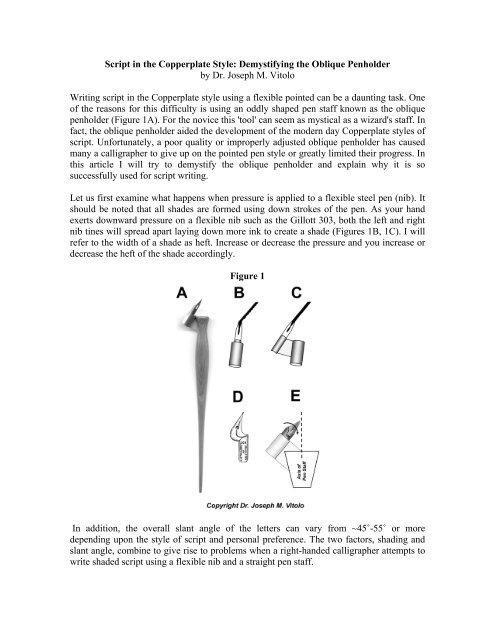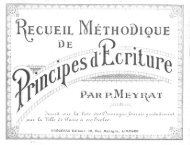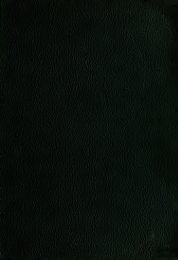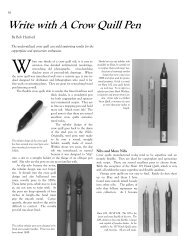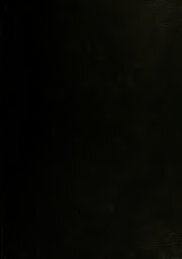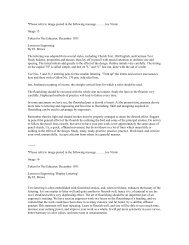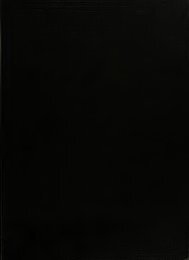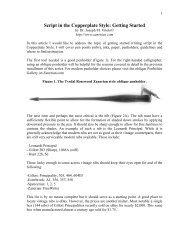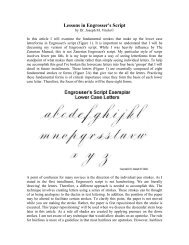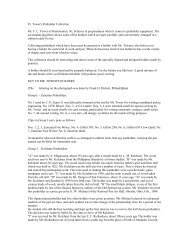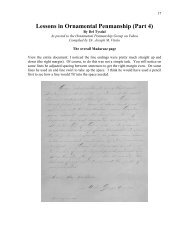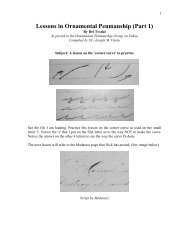Script in the Copperplate Style: Demystifying the Oblique ... - IAMPETH
Script in the Copperplate Style: Demystifying the Oblique ... - IAMPETH
Script in the Copperplate Style: Demystifying the Oblique ... - IAMPETH
You also want an ePaper? Increase the reach of your titles
YUMPU automatically turns print PDFs into web optimized ePapers that Google loves.
<strong>Script</strong> <strong>in</strong> <strong>the</strong> <strong>Copperplate</strong> <strong>Style</strong>: Demystify<strong>in</strong>g <strong>the</strong> <strong>Oblique</strong> Penholder<br />
by Dr. Joseph M. Vitolo<br />
Writ<strong>in</strong>g script <strong>in</strong> <strong>the</strong> <strong>Copperplate</strong> style us<strong>in</strong>g a flexible po<strong>in</strong>ted can be a daunt<strong>in</strong>g task. One<br />
of <strong>the</strong> reasons for this difficulty is us<strong>in</strong>g an oddly shaped pen staff known as <strong>the</strong> oblique<br />
penholder (Figure 1A). For <strong>the</strong> novice this 'tool' can seem as mystical as a wizard's staff. In<br />
fact, <strong>the</strong> oblique penholder aided <strong>the</strong> development of <strong>the</strong> modern day <strong>Copperplate</strong> styles of<br />
script. Unfortunately, a poor quality or improperly adjusted oblique penholder has caused<br />
many a calligrapher to give up on <strong>the</strong> po<strong>in</strong>ted pen style or greatly limited <strong>the</strong>ir progress. In<br />
this article I will try to demystify <strong>the</strong> oblique penholder and expla<strong>in</strong> why it is so<br />
successfully used for script writ<strong>in</strong>g.<br />
Let us first exam<strong>in</strong>e what happens when pressure is applied to a flexible steel pen (nib). It<br />
should be noted that all shades are formed us<strong>in</strong>g down strokes of <strong>the</strong> pen. As your hand<br />
exerts downward pressure on a flexible nib such as <strong>the</strong> Gillott 303, both <strong>the</strong> left and right<br />
nib t<strong>in</strong>es will spread apart lay<strong>in</strong>g down more <strong>in</strong>k to create a shade (Figures 1B, 1C). I will<br />
refer to <strong>the</strong> width of a shade as heft. Increase or decrease <strong>the</strong> pressure and you <strong>in</strong>crease or<br />
decrease <strong>the</strong> heft of <strong>the</strong> shade accord<strong>in</strong>gly.<br />
Figure 1<br />
In addition, <strong>the</strong> overall slant angle of <strong>the</strong> letters can vary from ~45˚-55˚ or more<br />
depend<strong>in</strong>g upon <strong>the</strong> style of script and personal preference. The two factors, shad<strong>in</strong>g and<br />
slant angle, comb<strong>in</strong>e to give rise to problems when a right-handed calligrapher attempts to<br />
write shaded script us<strong>in</strong>g a flexible nib and a straight pen staff.
Walt Disney once said, "Every l<strong>in</strong>e has two edges." This statement is especially important<br />
when consider<strong>in</strong>g a shaded l<strong>in</strong>e of significant heft. When a right-handed calligrapher uses a<br />
straight penholder and attempts to write script at <strong>the</strong> angles mentioned above a curious<br />
th<strong>in</strong>g happens. As <strong>the</strong> nib t<strong>in</strong>es spread and <strong>the</strong> pen moves across <strong>the</strong> paper, <strong>the</strong> right nib<br />
t<strong>in</strong>e will tend to drag across <strong>the</strong> paper leav<strong>in</strong>g a ragged edge on <strong>the</strong> right side of <strong>the</strong> shade<br />
(Figure 1B). This happens because <strong>the</strong> long axis of <strong>the</strong> nib is far off <strong>the</strong> ma<strong>in</strong> slant angle of<br />
<strong>the</strong> shaded stroke.<br />
It should be noted that this 'ragged edge' is not necessarily a negative s<strong>in</strong>ce France's Jean<br />
Larcher uses this ragged edge to great effect <strong>in</strong> his wonderful script. Many left-handed<br />
calligraphers do not face this issue when us<strong>in</strong>g a straight penholder s<strong>in</strong>ce <strong>the</strong>ir pen position<br />
usually, but not always, accommodates <strong>the</strong> slant angle. However, it is worth not<strong>in</strong>g that<br />
most 'lefties' that I know who are very proficient <strong>in</strong> script use an oblique penholder,<br />
<strong>in</strong>clud<strong>in</strong>g master penman John DeCollibus of Southboro, MA.<br />
In order to get both nib t<strong>in</strong>es to move smoothly over <strong>the</strong> length of <strong>the</strong> shade, <strong>the</strong> long axis<br />
of <strong>the</strong> nib should be on or very close to <strong>the</strong> ma<strong>in</strong> slant angle of <strong>the</strong> shade (Figure 1C).<br />
There are a few ways to accomplish this. One way to properly align <strong>the</strong> nib t<strong>in</strong>es would be<br />
to use a straight penholder and modify your hand and/or <strong>the</strong> paper position to facilitate<br />
mak<strong>in</strong>g a smooth shade. I do not recommend this approach s<strong>in</strong>ce this will place your hand<br />
<strong>in</strong> a very awkward writ<strong>in</strong>g position.<br />
A better approach is to mechanically angle <strong>the</strong> nib relative to <strong>the</strong> pen staff. This could be<br />
accomplished <strong>in</strong> one of two ways. First, nib manufacturers such as Gillott produced a<br />
flexible steel nib with an elbow bend for use <strong>in</strong> a straight penholder (Figure 1D). These<br />
'Elbow' nibs have been used effectively by many calligraphers. However, <strong>the</strong>y do not allow<br />
adjustment of <strong>the</strong> pen angle relative to <strong>the</strong> pen staff to accommodate an <strong>in</strong>dividual's<br />
personal writ<strong>in</strong>g style.<br />
The solution, and <strong>the</strong> approach embraced by past masters of <strong>the</strong> po<strong>in</strong>ted pen, was to<br />
modify <strong>the</strong> pen staff itself with an obliquely positioned flange (Figures 1A and 1C). The<br />
flange, usually made of metal, positions <strong>the</strong> entire nib at an offset angle relative to <strong>the</strong> long<br />
axis of <strong>the</strong> pen staff. This elim<strong>in</strong>ated <strong>the</strong> dragg<strong>in</strong>g of <strong>the</strong> right nib t<strong>in</strong>e across <strong>the</strong> paper.<br />
Smooth edged shades were now possible s<strong>in</strong>ce <strong>the</strong> nib is on or closely approach<strong>in</strong>g <strong>the</strong><br />
slant of <strong>the</strong> shaded stroke (Figure 1C). The earliest patent I have seen on this important<br />
tool was from England by Morden and Brockedon <strong>in</strong> 1831 (Sull).<br />
The placement of <strong>the</strong> nib <strong>in</strong> <strong>the</strong> flange is also important. The nib should be <strong>in</strong>serted <strong>in</strong>to <strong>the</strong><br />
flange so that <strong>the</strong> very tip of <strong>the</strong> nib is <strong>in</strong> l<strong>in</strong>e with <strong>the</strong> long axis of <strong>the</strong> staff of <strong>the</strong> pen as<br />
shown by <strong>the</strong> dotted l<strong>in</strong>e <strong>in</strong> Figure 1E. While some pen artists may prefer slight variations,<br />
a nib that has its tip positioned too far off <strong>the</strong> <strong>in</strong>dicated dotted l<strong>in</strong>e <strong>in</strong> Figure 1E will feel<br />
unbalanced when writ<strong>in</strong>g.<br />
The follow<strong>in</strong>g pen holder adjustments that I will discuss here are accommodations to <strong>the</strong><br />
modern day pen grip. The penmen/calligraphers of <strong>the</strong> golden age of American ornamental
penmanship were taught to hold <strong>the</strong>ir pens <strong>in</strong> a different fashion. However, that subject is<br />
beyond <strong>the</strong> scope of this article.<br />
Most modern premium oblique penholders, like <strong>the</strong>ir v<strong>in</strong>tage counterparts, have a metal<br />
flange that can be adjusted to better accommodate one's own style of hold<strong>in</strong>g <strong>the</strong> pen. If <strong>the</strong><br />
long axis of <strong>the</strong> nib, when view<strong>in</strong>g <strong>the</strong> pen from <strong>the</strong> side as shown <strong>in</strong> Figure 2A is <strong>the</strong> same<br />
as <strong>the</strong> long axis of <strong>the</strong> pen staff <strong>the</strong> nib-to-paper angle will be steep when writ<strong>in</strong>g. This<br />
could result <strong>in</strong> difficulty writ<strong>in</strong>g, excessive nib 'scratch<strong>in</strong>ess' and ultimately frustration.<br />
Figure 2<br />
The solution is to bend <strong>the</strong> nib/flange assembly so that <strong>the</strong> tip of <strong>the</strong> nib is positioned<br />
slightly upward. The result is a less steep nib-to-paper angle (Figure 2B) when compared<br />
to <strong>the</strong> unmodified holder held at <strong>the</strong> same writ<strong>in</strong>g position (Figure 2A). This will help<br />
facilitate writ<strong>in</strong>g and <strong>the</strong> nib should glide of <strong>the</strong> paper with much less difficulty.<br />
The f<strong>in</strong>al adjustment is to cant <strong>the</strong> nib/flange <strong>in</strong>ward slightly as <strong>in</strong>dicated by <strong>the</strong> curv<strong>in</strong>g<br />
arrow <strong>in</strong> Figure 1E. This adjustment allows both nib t<strong>in</strong>es to sit equally on <strong>the</strong> paper as <strong>the</strong><br />
hand rotates down <strong>in</strong>to <strong>the</strong> writ<strong>in</strong>g position. This adjustment is important s<strong>in</strong>ce good<br />
writ<strong>in</strong>g is next to impossible when only one of <strong>the</strong> two nib t<strong>in</strong>es is mak<strong>in</strong>g contact with <strong>the</strong><br />
surface of <strong>the</strong> paper.<br />
Ok, so you just purchased a premium oblique penholder and you’re still hav<strong>in</strong>g a very<br />
difficult time writ<strong>in</strong>g. While <strong>the</strong>re could be many reasons for this, such as a bad nib, poor<br />
paper, etc., for <strong>the</strong> purpose of this article we will focus on <strong>the</strong> penholder. A question that<br />
should be addressed, "Does purchas<strong>in</strong>g a premium oblique penholder <strong>in</strong>sure that <strong>the</strong> holder<br />
will be properly adjusted right out-of-<strong>the</strong>-box?" The short answer to that question is a<br />
disappo<strong>in</strong>t<strong>in</strong>g no. Of course, <strong>the</strong>re are exceptions such as <strong>the</strong> holders sold by master<br />
penmen such as Mike Sull (Figure 1A). These holders are handcrafted with custom fitted<br />
flanges that are properly adjusted before be<strong>in</strong>g sold.
The good news is that <strong>the</strong> metal flange of most quality penholders can easily be<br />
bent/adjusted us<strong>in</strong>g f<strong>in</strong>ger pressure. First, <strong>in</strong>sert a nib <strong>in</strong>to <strong>the</strong> flange <strong>the</strong>n align <strong>the</strong> tip of<br />
<strong>the</strong> nib with <strong>the</strong> center of <strong>the</strong> pen staff as shown by <strong>the</strong> dotted l<strong>in</strong>e <strong>in</strong> Figure 1E. Next<br />
gently bend <strong>the</strong> nib/flange assembly upward and slightly <strong>in</strong>ward as described above. The<br />
angles should roughly correspond to those shown <strong>in</strong> figures 1E and 2B. Once <strong>the</strong> desired<br />
angle is achieved be sure to re-align <strong>the</strong> nib tip with <strong>the</strong> center of pen staff.<br />
Remember that <strong>the</strong>se adjustments are meant to accommodate your hand. You will need to<br />
experiment to f<strong>in</strong>d <strong>the</strong> angle that best fits your hand. The <strong>in</strong>structions above will provide<br />
you with a great start<strong>in</strong>g po<strong>in</strong>t. For those wish<strong>in</strong>g to explore <strong>the</strong> images of modern and/or<br />
v<strong>in</strong>tage oblique penholders please visit Zanerian.com (http://www.zanerian.com).<br />
About <strong>the</strong> author<br />
Dr. Vitolo is <strong>the</strong> webmaster for both Zanerian.com 1 and The Ornamental Penmanship<br />
Group on Yahoo 2 . He developed a passion for Engrosser’s script, a form of script <strong>in</strong> <strong>the</strong><br />
<strong>Copperplate</strong> style. An historian of <strong>the</strong> golden age of American Ornamental Penmanship he<br />
is an active member of The International Association of Master Penmen, Engrossers and<br />
Teachers of Handwrit<strong>in</strong>g (<strong>IAMPETH</strong>) 3 . He has written several articles on<br />
penmanship/calligraphy and lectures extensively around <strong>the</strong> country on topics rang<strong>in</strong>g<br />
from science to penmanship. Dr. Vitolo holds two doctorates: one <strong>in</strong> Dentistry and a Ph.D.<br />
<strong>in</strong> Biochemistry. He is currently a Research Fellow with <strong>the</strong> Gene Therapy and<br />
Therapeutics Branch of <strong>the</strong> National Institute of Dental and Craniofacial Research <strong>in</strong><br />
Be<strong>the</strong>sda, Maryland.<br />
1 http://www.zanerian.com<br />
2 http://groups.yahoo.com/group/Ornamental_Penmanship<br />
3 http://www.iampeth.com<br />
Reference:<br />
Sull, Michael R. Spencerian <strong>Script</strong> and Ornamental Penmanship. 1st ed. Vol. 1. 2<br />
vols: LDG Publish<strong>in</strong>g, 1989.<br />
“How To Adjust your <strong>Oblique</strong> Holder” by Stephen A. Ziller<br />
http://www.zillerofkc.com/Services/<strong>Oblique</strong>Pen.html


